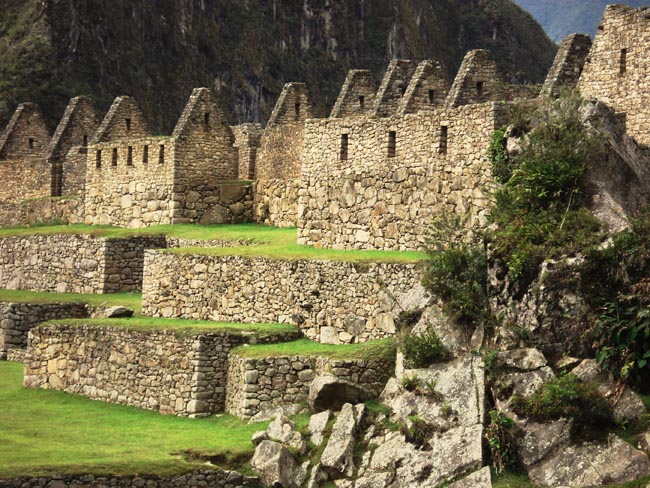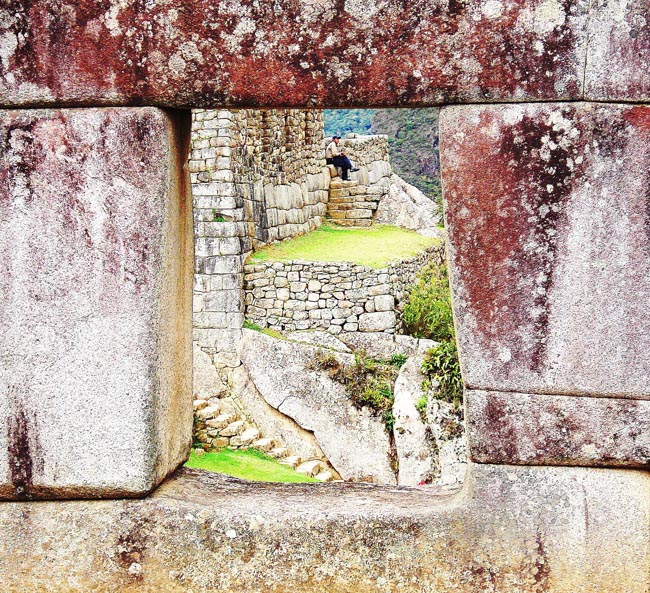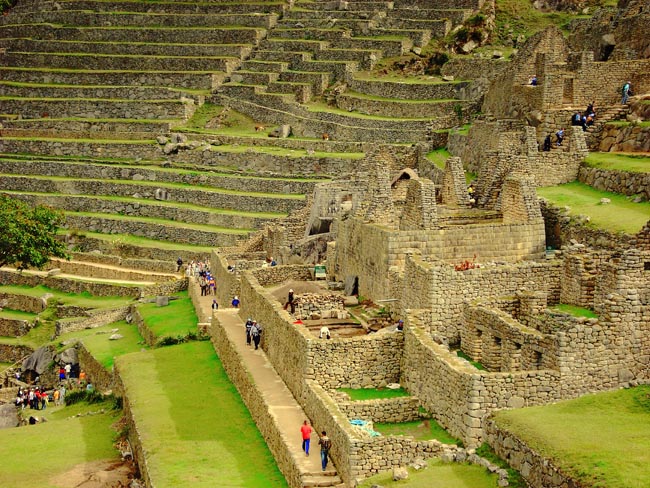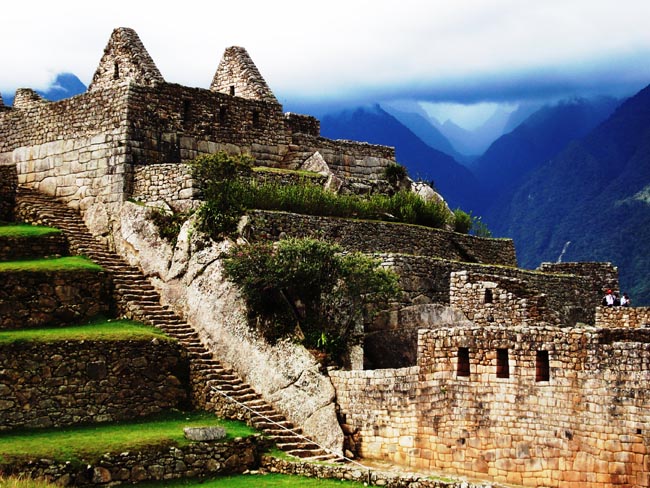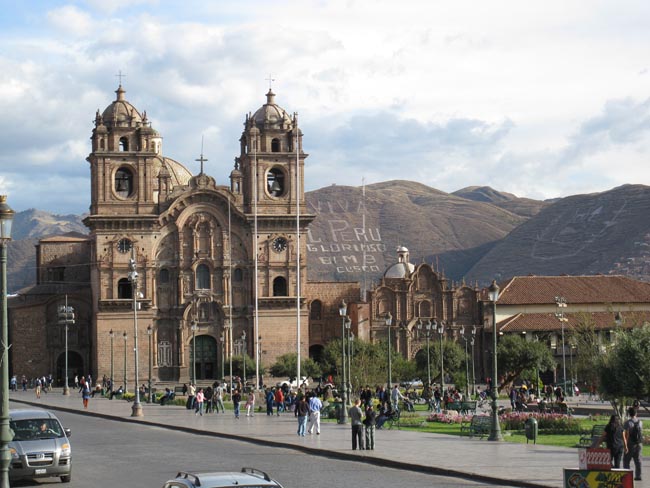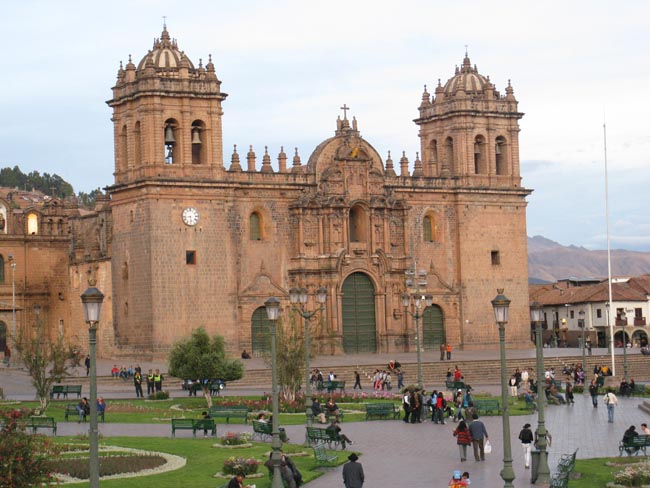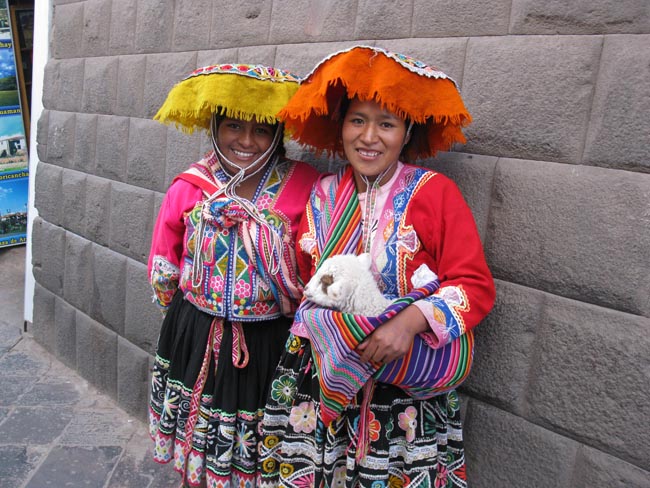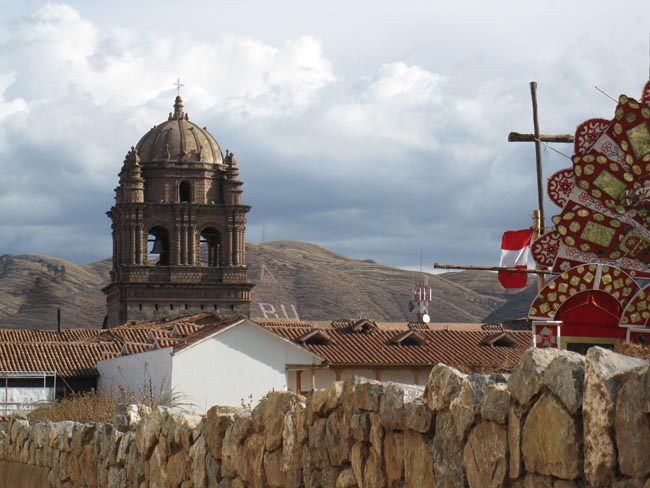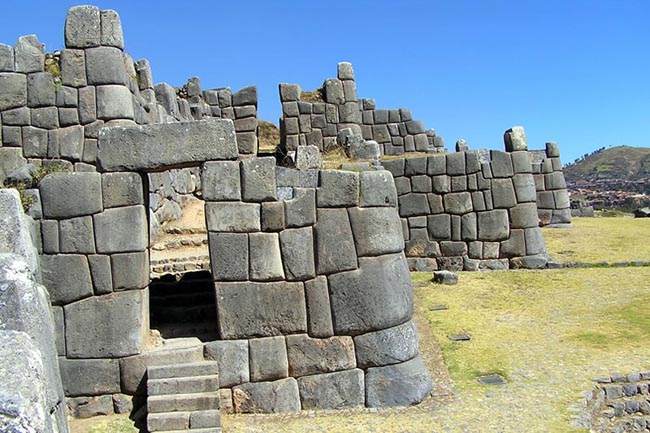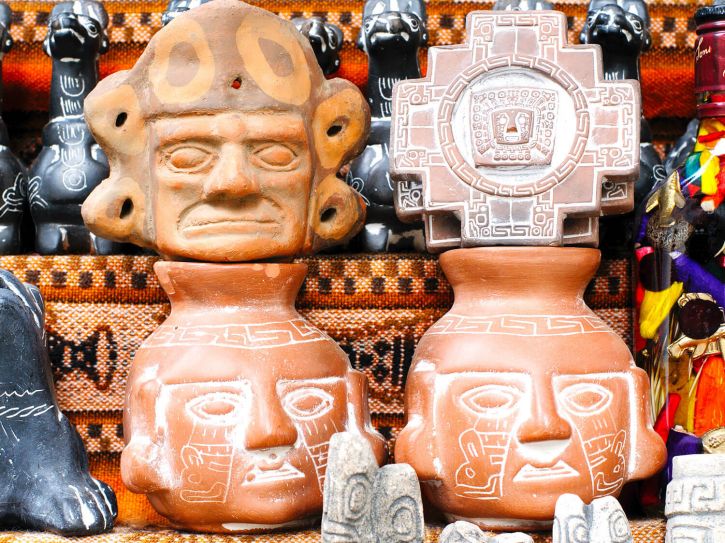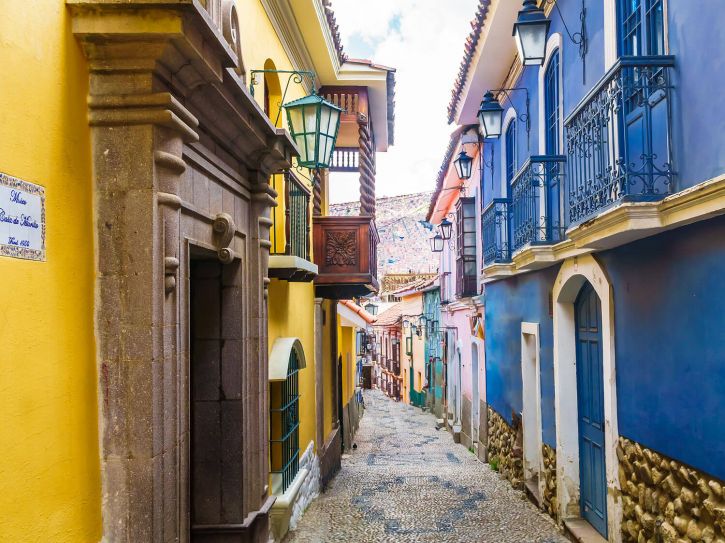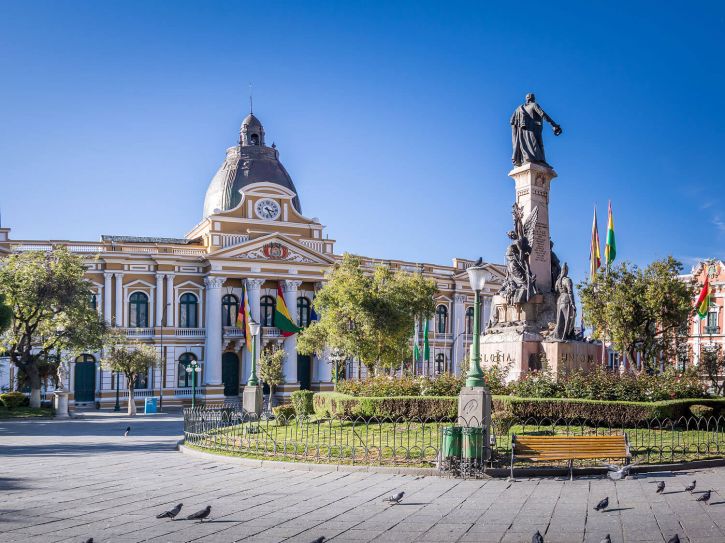Few places in the world offer the type of jaw-dropping scenery that serves as a backdrop for such a rich cultural experience as Peru and Bolivia tours do. From the soaring Andes that were once home to the Inca Empire, to the isolated tribes found in the Amazon Rainforest, Peru and Bolivia tours are the chance to blend a little adventure with cultural encounters.
For many, the reason for embarking on this journey to South America is for the chance to roam the cobblestoned ruins of Machu Picchu. The 'Lost City of the Incas' remains much of a mystery even to this present day, despite being around since the 15th century.
Our Peru and Bolivia tours spend two days at this site, offering a chance to explore the ruined temples and palaces with both a three hour guided walking tour, but as well an independent opportunity to rise early and witness the mist-covered mountains greet the morning light.
While it is true the first thing that comes to mind in the region is perhaps one of the grandest sets of ruins found in South America, it does not mean this is the only highlight. Even when thinking solely in terms of the Inca legacies, there are plenty of other sites visited within our Peru and Bolivia tours.
On a cruise around Lake Titicaca, we will witness the terraced slopes of Islas del Sol with three stone steps where water from a natural spring runs. These stone terraces have withstood weather and time along the shores of South America's largest and deepest lake, and these shimmering blue waters home to more than just the Inca heritage.
Today, the lake is also home to the Uros people. Famous for their totora reed islands in which they have floated in isolation for centuries on, the Uros have adapted to a life of fishing as well as surviving with the reeds being used as island foundations, furniture bases, boat materials, and even food.
Maintaining their traditional way of life, it is easy to understand the Uros people. But much like the Incas, Peru and Bolivia tours also encounter another civilization that has left archeologists baffled. We will visit the legacy of the Nazca peoples, who over 2000 years ago began building art on a massive scale into the landscape.
Over 300 figures were created using straight lines and geometric shapes, and our groups will venture into the skies to get the best bird's eye view. Determine whether the legends and explanations of ancient gods, alien encounters, celestial calendars, or practical maps is true, or simple marvel at the impressive lines etched into the pamas that surround the desert town of Nazca.
From ancient to recent, Peru and Bolivia tours offer a chance to explore a jewel in the Spanish colonial crown as the areas were once the most profitable regions for the empire in the Americas. Starting with the 'City of Kings' in Lima with rich museums that showcase 3,000 years of Pre-Columbian history, to the archeological capital in Cusco which is set in the fertile valley and sees Spanish mansions and churches built atop the foundations of Inca temples and palaces, there are many fine examples of Spanish influence.
Within the diversity in these colourful and imaginative places, Peru and Bolivia tours allow visitors to feel as though they have stepped into a cultural mecca, with an exciting history and scenic outlook available on almost every location visited.
Prices below are per person, twin-sharing costs in US Dollars (USD). Pricing does not include airfare to/from the tour and any applicable taxes. For single supplement rates and taxes (if any), please refer to below Prices & Dates table. For general information on flights to/from the tour, click here.
Your Travel and Accommodation Arranged For You
Tips Included for Driver, Restaurant Staff, Local Guides
Authentic Local Experiences With Lots Of Inclusions.
Select a date below to reserve your spot:
Optional Single Supplement: $1040 USD (number of singles limited).
This tour may require a mandatory single supplement charge of $160 if you join our share program and we are unable to pair you.
Download Itinerary
Day 1 Arrive in Lima
Today we arrive in Lima, Peru.
In recent years, this city has undergone some wonderful restorations of the plazas, ornate facades, and wooden balconies for which it is famous. Named the 'City of Kings' by the Spanish Conquistadors, Lima is the capital of Peru. Founded in 1535 by Francisco Pizarro, where the River Rimac meets the Pacific Ocean, this was the most important Spanish city during the colonial era with a population of about 100,000 inhabitants. Today the city is home to more than 7 million people.
NOTE: As most flights into Lima arrive close to midnight, we suggest that you consider adding an extra night in order to rest up. The hotel is comfortable and well-located, and our start time on Day 2 is likely an early one.
Overnight in Lima (Miraflores).
Included Meal(s): Dinner
Day 2 Lima - Paracas & Nazca Lines Scenic Overflight
We have an early morning private transfer to the bus station for the PUBLIC BUS to Paracas (4-5 hrs). On arrival transfer from the station to our hotel in Paracas. After a brief break for refreshment, we will head directly to the Pisco Airport to board your scenic overflight of the 2,000 year old Nazca Lines, comprised of about three hundred figures made of straight lines and geometric shapes most clearly visible from the air.
The lines were supposedly built by an ancient civilization called the Nazca, though no one knows for sure who built them or why. Since their discovery, the Nazca Lines have inspired fantastic explanations from ancient gods, a landing strip for returning aliens, a celestial calendar, used for rituals probably related to astronomy, or a map of underground water supplies. Your total flying time will be about one hour; the total time spent over the lines themselves will be approximately 25-35 minutes.
After the flight we drive back to our hotel in Paracas for dinner and overnight.
Included Meal(s): Breakfast and Dinner
Not finding what you're looking for?
Our specialists can take away the stress and create a private custom tour tailored to your exact interests and budget.
Day 3 Ica Regional Museum, Winery & Huacachina Lagoon
After breakfast, we visit the Regional Museum of Ica "Adolfo Bermúdez Jenkins," a significant cultural institution in Peru. This archaeology and anthropology museum offers a deep dive into the rich history and culture of the region, primarily dedicated to the Paracas culture, an Andean society known for its intricate textiles and complex societal structures. The museum has dedicated exhibition rooms showcasing artifacts and information about this culture, providing visitors with a unique opportunity to learn about this ancient civilization.
We then visit one of the traditional wineries of Ica, which can lay claim not only to the lion’s share of Peruvian production, but also to some of the oldest and longest established wineries in the New World (500+ years). Most of the vineyards in Ica are planted on the flatlands, hugging the riverbanks and irrigation channels — access to water is vital in this arid desert. The dry, sunny climate and free-draining sandy soils with their ample water supply allowed viticulture to thrive and you’ll still find many hundred-year-old vines in a perfectly healthy condition.
Later we drive to the village of Huacachina, built around a small lake in the desert. Called the "Oasis of America," it serves as a resort for local families from the nearby city of Ica. Legend holds that the lagoon was created when a beautiful native princess was apprehended at her bath by a young hunter. She fled, leaving the pool of water in which she had been bathing to become a lagoon.
Return to Paracas for dinner and overnight.
Included Meal(s): Breakfast and Dinner
Day 4 Paracas - Ballestas Islands - Lima
This morning we enjoy a (shared) boat trip to the spectacular Ballestas Islands, often described as Peru's answer to the Galapagos. Though they don't quite match the splendour of their Ecuadorian cousins, they are quite spectacular in their own right. The islands have been eroded to form countless natural caves and arches. In fact, this is where the islands' name comes from -- the word Ballesta means 'bow' (as in archery). There are colonies of thousands of seabirds such as pelicans, Inca terns and cormorants as well as a small colony of Humboldt penguins. You will also see hundreds of sealions and often schools of dolphin.
We return to Paracas and the take the bus north, arriving back in Lima late afternoon. Tonight we meet other incoming group members who are not participating in the Nazca extension.
Overnight in Lima (Miraflores).
Included Meal(s): Breakfast and Dinner
Day 5 Lima: City Tour
This morning we will make our way to the Plaza de Armas, the most important plaza in Lima. The oldest surviving part of the plaza is the impressive bronze fountain, erected in 1650. Surrounding the plaza is the exquisite Archbishop's Palace, the cathedral, and the Government Palace where handsomely uniformed presidential guards are on duty all day. We visit the cathedral where the great conquistador Francisco Pizarro's tomb lies. After, we will continue to San Francisco's Church to visit the extensive catacombs that lie underneath, before then stopping for some lunch at Ficus Hacienda. Here we will also get to enjoy a wonderful exhibition of beautiful Peruvian Paso horses.
We then proceed to the Larco Museum, which showcases remarkable chronological galleries and an excellent overview on 3,000 years of development of Peruvian pre-Columbian history. Located in a unique vice-royal mansion of the 18th century built over a 7th century pre-Columbian pyramid, is surrounded by beautiful gardens. Features the finest gold and silver collection from ancient Peru and the famous erotic archaeological collection, one of the most visited Peruvian tourist attractions. For an unforgettable experience, Larco is one of the few museums in the world where visitors can also choose to enter the storage area with its 45,000 classified archaeological objects.
Later we head to the trendy area of Miraflores where people stroll along the cliff tops and watch the sun setting on the Pacific Ocean. The best location is the new "Love Park," with its magnificent monument to lovers at its centre.
Dinner will be on your own this evening.
Overnight in Lima.
Included Meal(s): Breakfast and Lunch
Day 6 Lima - Fly to Cuzco - Urubamba Valley - Ollantaytambo - Yucay
Early this morning we fly to Cuzco, located in a fertile valley at 3354 m (11,004 feet). This is the archaeological capital of the Americas and the ancient capital of the Inca Empire that, at its height, stretched from Colombia in the north, through Ecuador, Peru and Bolivia, and down to central Chile in the south. Although the empire already existed in the 12th century, it remained small until the mid-15th century. Over the next 100 years, it expanded massively but declined due to the civil war and the conquest by the Spanish conquistadors under Francisco Pizarro in 1533.
On arrival we will travel by road into the Urubamba Valley, or "Sacred Valley of the Incas," along one of the most scenic drives on our trip, to the Inca ruins of Ollantaytambo located on a spectacular ridge with deep valleys on either side. We can admire the carefully constructed and maintained farming terraces on the surrounding hillsides.
We continue to the town of Yucay on the bank of the Urubamba River (2300m / 7,590 ft). This is an attractive little town of particularly fertile lands whose name translated into Spanish means "deceit" or "bewitchment". According to legend, in the middle of the 15th century, the Inca Huayna Capac was captivated by the incomparable magnificence of Yucay's setting and decided to settle here.
Overnight in Yucay.
Included Meal(s): Breakfast and Dinner
Day 7 Yucay - Machu Picchu Area
Today we take the early morning train* from Urubamba to Aguas Calientes and Machu Picchu. The train journey to Machu Picchu is a highlight of any trip to the Andes; the scenery is simply spectacular, and the train allows you to enjoy it in comfort. The +/- 3 hour trip takes us through a changing landscape with wonderful vistas of the mountains and, deep in its dramatic canyon, the beautiful Urubamba River. Our early arrival from Urubamba ensures that we are at the site before the tourist throngs arrive on the train from Cuzco later in the morning.
Machu Picchu, popularly known as the 'Lost City of the Incas,' is an ancient city of stone palaces, towers, temples and staircases. It is a very mysterious place, and to this day our knowledge of it remains sketchy. There are no records or artifacts on the site to indicate what any of the buildings were used for. Archaeologists have ascertained that the site was most likely a ceremonial centre and possibly used for administrative purposes for the populous region.
Upon arrival at the Aguas Calientes train station, a bus will take us on the 6 km (4 mile) twisting journey up the mountainside to the site of Machu Picchu. Having already dropped our baggage at our hotel, we proceed immediately for a 2-hour guided walking tour of Circuit 1 (the Upper Terrace route). After a break for lunch, we will then continue with another 2-hour guided walking tour, although this time we will be following Circuit 2B. During these guided tours, we will see, among other features: the Intihuatana pyramid, the Water mirrors complex, the Plaza of the Sacred Rock, and the prison-like Temple of the Condor.
After our tours we will proceed back to our hotel.
* PLEASE bring an overnight bag for this one night at Aguas Calientes as the train enforces strict luggage limits. Our larger bags will be transported back to Cuzco for us. Please also note that, due to group size limits, groups exceeding 15 participants will be split between two guides for today's site tour.
Overnight at Agua Calientes (near Machu Picchu).
Included Meal(s): Breakfast and Dinner
Day 8 Machu Picchu Area - Cuzco
A large part of the beauty of Machu Picchu is created by its setting on a mountain top surrounded by deep valleys. By staying for a second day to visit Machu Picchu, rather than visiting as a day trip from Cuzco, we are able to savour the atmosphere of this very special place.
In the early morning of our second day at Machu Picchu, some group members may choose to take the bus back up to the site with the weather-dependent hope of seeing the mist-clad mountains greet the morning sun (an optional excursion). Weather notwithstanding, the best thing about going up the second day is being there early when there are fewer people, allowing time to "soak it in," as well as the opportunity to climb Huayna Picchu.
During our time in the village below the site, we will also include a visit to the Manuel Chavez Ballon Site Museum, which focuses on the "discovery," excavation, and history of Macchu Picchu. On display are historical photos, including photos of Hiram Bingham at Machu Picchu shortly after he came across the ruins, informative write-ups on the construction of Machu Picchu and the life of the Incas, and artifacts found at the site. Outside the museum is a very lush botanical garden running along the river; some plants are labelled and there are a few short trails. This is a nice shady area to rest on a hot day and is an easy 25 minute walk from Aguas Calientes down the road leading to Machu Picchu.
Later in the afternoon we board the VISTADOME train from Aguas Calientes to Ollantaytambo Station (1.5 hours) from where we bus back to Cuzco.
* DUE TO strict limits on the number of visitors daily, if you elect to visit again today (optional - at your expense), you will need to book well advance online via www.ticketmachupicchu.com. You will need to choose the EARLIEST options for Machu Picchu only OR Machu Picchu & Huayna Picchu if you want to hike Huayna Picchu (a difficult walk).
Overnight in Cuzco.
Included Meal(s): Breakfast and Dinner
Day 9 Cuzco Area
This morning we visit some of the most important Inca sites in the Cuzco area.
Sacsayhuaman is an impressive complex which, like so many others of that time, had both a religious and military purpose. The fortress known as the 'storehouse of the sun' incorporates some of the largest stones ever used in a building. The zig-zag walls represent the teeth of the sacred puma and provide an excellent defensive structure. The stones fit so perfectly together without mortar that not even moss can grow in the cracks!
In the afternoon we return to Cuzco and enjoy a tour of the town. We visit Coricancha, the temple of the sun which was the most important location in the Inca empire. Entombed in the closed cloister of the Sto Domingo Church, these sacred walls were hidden from modern civilization until the colonial walls were brought down in 1950 by a powerful earthquake. We also visit the church of San Blas with its fabulously carved pulpit. Wandering the narrow streets of the San Blas artisan region we make our way to the cathedral which towers impressively over the Plaza Mayor. Inside we find precious paintings from the Cuzco School of Art, one of the most prolific of its era.
This Inca city was laid out around a great central square in the shape of a puma, the god of lightning. Today, stone walls built by the Incas line most of Cuzco's central streets and form the foundations of colonial and modern buildings. The Inca buildings were so well built that the Spaniards simply knocked down the upper parts of the Inca temples and palaces and built their churches and mansions on top of the Inca walls. Shortly after the Spanish conquest, the capital was moved to Lima on the coast. Thus Cuzco has retained a wonderful, untouched colonial atmosphere. The culture is also very much alive here, and is evident in the music, clothing and handicrafts of the people.
We have dinner at a local restaurant where we can try some typical Peruvian dishes. One may wish to try the "Pisco sour", a powerful drink made with a Peruvian liquor distilled from white grapes.
Overnight in Cuzco.
Included Meal(s): Breakfast and Dinner
Day 10 Cuzco & Pisac
This morning we visit the ruins at Tambo Machay, Puca Pucara and Qenko. The latter is an Inca sacrificial site carved with inscriptions.
We continue to Pisac with its lively market where you will encounter traditionally dressed locals with whom you can barter for colourful craft items. You will see many unique Andean musical instruments as well as dazzling textiles. Peruvian woolen items are justifiably famous for their imaginative designs, based on Inca art and the local flora and fauna. You can buy sweaters and caps made from the extremely warm wool of alpacas and llamas.
We return to Cuzco with balance of the day at leisure.
Overnight in Cuzco.
Included Meal(s): Breakfast and Dinner
Day 11 Cuzco - Pucara - Raqchi - Puno & Lake Titicaca
Today we travel by road to Puno on the shores of Lake Titicaca (+/- 7 hours, with stops).
From Cuzco, we head south-east, through green fields dotted with willow trees and eucalyptus groves, passing outlying communities gathered around colonial churches that conceal their artistic treasures behind crumbling adobe facades. The first half of the journey is dominated by magnificent Andes followed by the gentler, rolling Andean Plains, where vicuna and alpaca are often seen. This is a wild, high, windswept and sunburned prairie of isolated communities of shepherds and cattle farmers, wedged between the two distant branches of the Andes visible occasionally on either horizon, when not melting completely with the giant cumulus clouds that dominate the skyline.
Along the way we visit Pucara (aka Pukara), where we visit the ruins of the Pucara culture and its museum, located at the breathtaking elevation of about 3900m (almost 13,000 feet). This town is known across Peru for the archaeological site of Pukara and a vibrant modern pottery-making tradition. The fort is made of large walls, terraces, and staircases and was part of defense of Cuzco in particular and the Inca Empire in general.
We then stop at Raqchi and the ruined Temple of Wiracocha, named for a deity believed to be the giver of all life; the temple was thought to be built to to appease him and honour him. The temple is said to be specifically built so that people had to walk in a zigzag motion, which is related to the relationship between Wiracocha and Inca cosmology.
Finally we will pay a visit to the district of Andahuaylillas with its Baroque church, known as the "Sistine Chapel of South America".
Puno, at 3830m (12,562 feet), is the main settlement on the Peruvian shore of Lake Titicaca and the highest place on our tour in which we will spend some time. Puno is the greatest centre of Peruvian folk dancing and traditional instruments; the markets and streets of Puno are bustling with the brightly-coloured costumes of the different groups of the region.
Overnight in Puno.
Included Meal(s): Breakfast, Lunch and Dinner
Day 12 Lake Titicaca: Floating Islands & Taquile Island
We will begin our day by visiting the floating islands of Los Uros. The Uros people began their floating existence centuries ago in an effort to isolate themselves from their rivals, the Collas and the Incas. Today, about 300 people live on the islands. The islands are constructed from many layers of floating tortora reeds which grow in the shallow waters of Lake Titicaca. The reeds rot away from the bottom and are replaced at the top, so the ground is soft and springy as you walk over it. Even the buildings on the islands are made of tortora. The whole life of the Uros people revolves around the reeds. They even eat the lower stalk and root, which is supposed to taste like celery.
Today the Uros live mainly from fishing, including catching the giant pejerray which can grow up to 13.5 kg / 30 lb.
Later today we will make our way to Taquile Island. Here we will have some time to explore and also have lunch in a local home.
Overnight in Puno.
Included Meal(s): Breakfast and Lunch
Day 13 Puno, Peru - Copacabana, Bolivia
Today we travel round the Peruvian side of the lake and cross into Bolivian territory. The village of Chucuito is built over an Inca settlement and has an Inca sundial on display which was assembled in the mid-1800s using colonial, Inca, and modern era stones. The turbulent history of the lake region can be seen in the many Inca and pre-Inca sites as well as Spanish colonial churches dotted across the area.
We drive along the western shores of the lake taking in various small towns which are famous for their colonial churches and architecture. One of the most unusual towns along the lake is Juli, which has four huge churches and yet is a small town. The town was originally the Spanish capital of the lake region and the Spaniards hoped to convert most of the indigenous population to Catholicism. While building the Church of Santa Cruz the local stonemasons incorporated Inca motifs into the Christian decorations.
This afternoon we will enjoy a relaxed walking tour of Copacabana. For centuries, Copacabana has been a site of religious pilgrimage, beginning with the Incas. We visit the Cathedral of the Indian Virgin, built between 1605 and 1820. It is a brilliant Moorish structure with mudejar domes, colourful azulejos (decorative tiles), and a beautiful church courtyard decorated with wonderful flower gardens. Every year, hundreds of thousands of pilgrims travel from distinct parts of Bolivia and other Latin American countries to take part in religious festivals in Copacabana. Legend says that if the statue is removed Lake Titicaca will rise up and flood the whole Altiplano region.
For the energetic, there is a walk up to Cerro Calvario (Calvary Hill) for beautiful views of the town and lake. Pilgrims pass the 14 stations of the cross to reach the top but once there they encounter, as so often in Bolivia and Peru, a fusion of Catholic and pagan beliefs.
Overnight in Copacabana.
Included Meal(s): Breakfast and Dinner
Day 14 Lake Titicaca
Today is spent exploring Isla del Sol in Lake Titicaca by boat. This is the most important of the thirty-six islands in the lake. Lake Titicaca, South America's largest lake, straddles the Bolivia-Peru border and is said to be the highest navigable body of water in the world at an altitude of 3810 m (12,497 ft). Lake Titicaca was once much larger than the 8560 sq kilometres (3,305 square mi) it occupies today. The great city of Tiahuanaco was built at the edge of the lake, but today it is more than 25 km (15 mi) from the lake. This reduction in the lake size has had a tremendous effect on the climate of the Altiplano region over the past 1,000 years and has made this cradle of cultures able to support far fewer people today.
The cleverly terraced slopes of Isla del Sol contain numerous ruins and small traditional villages. We see the Inca steps where water from a natural spring runs through three stone channels. The sacred water is supposed to cure ailments and bring long life. The three stone channels represent the three commandments of Inca life: Don't Lie, Don't Steal, and Don't be Lazy. The Inca society was highly organised and industrious; laziness was punishable by death.
Later today we return to Copacabana. You may like to take a stroll along the lake shore at sunset.
Dinner on your own this evening.
Overnight in Copacabana.
Included Meal(s): Breakfast and Lunch
Day 15 Copacabana - Tiahuanaco - La Paz
This morning we drive towards La Paz. We take first a ferry across from the peninsula on which Copacabana sits to the Bolivian mainland and drive to La Paz, one of the world's highest major cities.
En route we stop at Tiahuanaco. This flat, desolate landscape would not seem capable of supporting life, and yet this is where the majority of Bolivia's population live. Here we may see llamas and alpacas, the only surviving relatives of the camel found in the Americas. Tiahuanaco is an ancient ceremonial site constructed around AD 700. After about AD 1200 the Tiahuanaco people disappeared, becoming another 'lost' civilisation. We know little about the people of Tiahuanaco but it is believed that their civilisation developed over a period of 2,000 years and then mysteriously vanished.
Our destination is La Paz, located at 3686 m (12,090 ft) above sea level. La Paz is situated in a bowl-shaped canyon in the Cordillera Real (Royal Range) of the Andes. As we travel across the Altiplano, the ground suddenly drops away 400 m (1,312 ft) to reveal the city hidden in a bowl in the mountains.
Overnight in La Paz.
Included Meal(s): Breakfast, Lunch and Dinner
Day 16 La Paz: City Tour
The mountains surrounding La Paz soar to an average of 5500 m (18,040 ft) above sea level. The most spectacular views of the city come on a clear evening when one can see the twinkling lights of the city stretching up the hillsides, under the the snow-capped triple peak of Mount Illimani at 6402 m (20,999 ft).
Today will explore the Spanish colonial quarter of the city and visit the Archeological Museum of Bolivia, which has a special exhibit dedicated to the site of Tiahuanaco visited yesterday. We also experience the colourful markets of La Paz. The markets are a great place to observe the colourfully-dressed native Quechua and Aymara-speaking people. The women wear many layers of petticoats covered by a colourful dress, and over their shoulders they sling a multi-coloured striped blanket called a 'phulla' in which they carry their groceries or babies -- or both! On their heads they wear a bowler hat (which always appears to be too small) at a jaunty angle. The British brought the bowler hat to Bolivia when they were building the railway and somehow it became part of the everyday dress of Andean women.
We finish our day with a visit to a great place to buy some of the handicrafts, such as colourful sweaters woven from sheep's wool or from the light-weight, very warm wool of the native Andean animals. We finish at the unusual Mercado de los Brujos, better known as the Witches' Market, where you will see all sorts of potions, herbs and folk remedies used to guard against evil spirits.
Overnight in La Paz.
Included Meal(s): Breakfast and Dinner
Day 17 Departure
Departure from La Paz.
BUEN VIAJE!
Included Meal(s): Breakfast
Inclusions
Breakfast and dinner daily (hotels and local restaurants). All transport, sightseeing and entrance fees for sites noted as 'visited' in the detailed itinerary. Gratuities for local guides, drivers, restaurant staff, porters. Airport transfers for land & air customers and for early arriving / late departing land & air customers who book their extra hotel nights through us.
Exclusions
International airfare to/from the tour. Tour Leader gratuity, lunches, drinks, personal items (phone, laundry, etc), departure taxes, domestic and international air taxes (if applicable). Airport transfers for Land Only customers. Optional trip cancellation insurance. Our post-reservation trip notes offer further guidance on optional meal costs, shopping, and locally paid departure taxes.
Seasonality and Weather
This tour is offered throughout the year. The cool and dry season runs from May to October; outside this time you will encounter warmer but perhaps rainy / misty conditions in the mountains. Serious heat / humidity are only a consideration in Lima and Nazca.
Transport and Travel Conditions
The Nazca excursion is run and organized by a local operator. Road transport on our tour via private air-conditioned motor coach, 24-36 seats depending on ultimate group size (see 'group size').
Numerous walking tours on uneven surfaces. Most of this tour occurs at high altitude and, though our itinerary spends a night at Yucay before climbing higher to Cuzco, some people are affected-check with your doctor.
Scenic VISTADOME train Aguas Calientes - Cuzco. Internal flight via scheduled local carrier.
Am I suitable for this tour? Please refer to our self-assessment form.
Activity Level: 2
These are particularly busy tours that feature a lot of moving around, sometimes by train and short journeys on local transport. Walking tours of towns and cities are leisurely but you should be prepared to be on your feet for several hours. Some of our cultural trips that occur at high altitude and/or require greater independence with baggage handling (at hotels, airports, train stations) also fall into this category.
To learn more about the Activity levels, please visit our tour styles page.
Accommodation
Well-located, heated / air-conditioned, mid-range (3/4 star) hotels with en suite toilet and bath throughout (probably shower only). Single rooms are limited and likely smaller than doubles. Porter service is usually available though you should be independent with your luggage, especially at airports and train stations.
Staff and Support
Tour Leader, driver/s, and local step on guides.
The Nazca / Ica extension portion of this tour will be escorted by a local guide / agent. You will meet your Adventures Abroad Tour Leader upon arrival back in Lima.
Group Size
Maximum 18 plus Tour Leader
Tour Extensions
This tour is part of a series that can be upgraded to make for a longer trip. For more options, please refer to tour code/s:
Tour Overview Countries Visited: 2 Acivity Level: 2 Tour Style: Cultural
Enjoy a varied sample of the abundance of South America as we travel to Ecuador, Peru and the Galapagos Islands on this exiting three-week Ecuador & Peru tour, an adventure to witness the nature, culture and attraction of three world-class tour destinations.
In Ecuador, we tour the historic colonial centres of the capital, Quito, now preserved by UNESCO as a World Heritage Site and delight at standing on the exact geographical point of the equatorial divide, with one foot in the Northern and the other in the Southern Hemisphere.
Heading to Cuenca yields a cityscape comprised of charming houses, cobblestone streets and romantic plazas and our route via Ingapirca in the Canar Valley takes us through Ecuador's most important Inca site.
In Peru, the centuries-old churches, ornate cathedrals and exquisite palaces keep us awed in the bustling capital, Lima, and then it's off down the 'Sacred Valley of the Incas' via the archaeological capital of the Americas and what was once the ancient capital of the great Incan Empire, Cuzco.
The highlight of any trip to the Andes is, without doubt, a tour of Machu Picchu, also known as the 'Lost City of the Incas'.
An intriguing and visually stunning place whose purpose remains a mystery to this day, Machu Picchu is an ancient city of stone palaces, towers, temples and staircases that captures the imagination and bewitches the senses.
Glorious sceneries of plunging valleys and jungle-encroached temples mark our route as we head to Cuzco, where we find indigenous and colonial history and in Pisac, we investigate traditional huts built from mud bricks, peruse colourful markets and taste local culinary delicacies.
In the midst of all this, we set sail for the Galapagos Islands, where we experience the legendary volcanic landscapes, unusual flora and fauna and teeming wildlife on this remarkable archipelago whose islands truly are miniature worlds unto themselves.
Tour Overview Countries Visited: 2 Acivity Level: 2 Tour Style: Cultural
For a comprehensive overview of the diversity and splendour of nature in South America, this thrilling Ecuador & Peru tour is definitely the one to opt for.
For an adventure-packed 30 days, we travel through three unique destinations across this magnificent continent and bear witness to sights that even the most vivid imagination could not do justice to.
On a tour marked by superlatives that have to be seen to be believed, we begin our adventure by drifting down the longest river in the world with the world's largest and most abundant rainforest as a backdrop.
Exotic species of flora and fauna, vibrant in colour and iridescent in beauty, line our course and when we once again take to land, we make route for the Avenue of the Volcanoes, a stretch of snow-crested peaks, mystical brooks and small villages with terraced farmland.
Exploration of the bustling capital city, Quito, makes for a pleasing contrast to our subsequent departure for the uninhabited natural wonderlands of the Galapagos Islands, an archipelago that has remained untouched for millennia and which has thereby managed to cultivate a special environment brimming with unique ecosystems and extraordinary diversity and abundance of wildlife.
Nowhere else on the planet offers such rewarding opportunities to get up-close and personal with countless species of land- and marine- animals that have never learned to fear the presence of Man; the magic of the Galapagos never fails to spellbind.
From here, it's on to Peru's capital, Lima, to venture through ancient underground catacombs and tour majestic palaces, beautiful cathedrals and museums rich with Incan and pre-Incan relics treasures.
As we journey through the Urubamba Valley, also known as the 'Sacred Valley of the Incas', we admire one of the most scenic drives on our trip and stop off to explore Inca ruins and cave tombs before we reach the bewildering 'Lost City of the Incas' at Machu Picchu.
Tour Overview Countries Visited: 3 Acivity Level: 2 Tour Style: Cultural
Nestled in the shadows of the Pichincha volcano high in the Andes, Ecuador's capital city, Quito, boasts a wealth of attraction and a natural environment that can be described as nothing short of stunning.
It is here that we begin our mammoth 32-day trek through South America on this Ecuador, Peru & Bolivia tour.
The initial week of this outstanding tour is spent strolling alongside centuries-old architecture of palaces and churches in the World Heritage-designated colonial urban centres of Quito.
We follow the 'Avenue of the Volcanoes' past snow-capped summits and mystical rivers amid the Cordillera Mountains, relaxing in quaint villages that enjoy worldwide fame for their spirit-replenishing hot springs, and perusing the stalls of traditional markets alive with drifting melodies of Andean pipe music and Quichua; the native language derived from the Incan tongue.
A boat trip on transparent waters around the naturalist wonderlands of the Galapagos Islands truly is a once-in-a-lifetime experience and periodic dockings ensure we get up-close and personal with a diversity of flora and fauna that no destination in the world can rival.
Penguins, tortoises, sea lions and iguanas are but a few species of the massive range of wildlife that we encounter as we discover why this special destination, which has changed little since the days of Darwin, remains one of the most popular destinations in the world.
Flying into Lima, Peru, we tour the many sights of what was one of the most important cities in South America during the Spanish colonial era.
From its underground catacombs and intricately carved churches, to its recently-restored plazas, ornate facades and wooden balconies, Lima evinces an atmosphere of former glory at every turn and with about one-third of the population taking up residence in the capital, it gives travellers valuable insights into contemporary Peruvian culture and society.
Along the Urubamba Valley, we find one of the most scenic routes in the country and exploring the temple and pyramid ruins of the 'Lost City of the Incas' at Machu Picchu is to appreciate fully the architectural, engineering and design genius of one of the most influential and mysterious civilizations in the history of the Americas.
Through mud-brick villages with colourful local markets on the Andean Plains, we make headway for Bolivia, stopping often en route to take in historic and cultural attractions found off the beaten path.
Bolivia is an out-of-the-way destination like no other, a feature that allows us to enjoy a country very much in its natural state; its long isolation has meant that Bolivian lifestyles, traditions and the country's natural environment have been wholly preserved over the years.
It is a land wherein women still wear multi-coloured petticoats and rural locals still weave ponchos, like their ancestors did, and is entirely unspoiled by the influence of mass tourism; its rough edges only adding to the sense of adventure.
Tour Overview Countries Visited: 3 Acivity Level: 2 Tour Style: Cultural
Peru's capital city was once called 'The City of Kings' by Spanish conquistadors and it is here that we begin our 28-day Peru, Bolivia & Ecuador Tour through South America.
Using Lima as a base, we catch a flight to view the curious phenomenon of the Nazca lines; approximately three hundred figures made of straight lines and geometric shapes that are most clearly visible from the air, which were supposedly built by the ancient civilization of the Nazca, but to what end, no one can say with certainty.
Most tours to the Nazca lines include a trip to Peru's answer to the Galapagos Islands - the spectacular Ballestas Islands - and then it's back to Lima for further exploration of the destination that was once the most important and richest city in the Americas.
We meander in grand plazas, gaze at intricately carved churches and cathedrals and tour breathtaking underground catacombs as we learn about the area's fascinating colonial history.
Travelling southeast through spellbinding landscapes of deep, forested valleys and towering mist-encircled mountains, we drive to Machu Picchu for one of the highlights of our adventure: exploration of the majestic temples, gigantic pyramids and stone staircases built by the great Inca Empire of ancient times.
Through mud-brick villages wherein locals are adorned in traditional attire and green fields dotted with willow trees and eucalyptus groves, we journey east to Bolivia, stopping off en route for a short boat ride on a lake to see the unique lifestyles of islanders.
For five days, we admire the abundant natural and man-made attractions of Bolivia: the fascinating colonial centres of Copacabana; the tranquility of Lake Titicaca and the lakeside trenches built by the Incas to channel the sacred water; museums brimming with pre-Columbian artifacts and relics; ancient ceremonial sites of 'lost' civilizations; colourful marketplaces; and glorious sceneries of Andean snow-tipped peaks and plunging valleys with tropical jungle.
From here, it's on to the pristine Amazonian rainforests of Ecuador to see teeming wildlife and lush flora as we tour the country's remarkable natural environment.
As we make our way along the 'Avenue of Volcanoes', we see snow-capped summits, mystical brooks and rivers, terraced farmlands, small villages and fascinating cultures and reluctantly fly home from the capital, Quito.
Tour Overview Countries Visited: 3 Acivity Level: 2 Tour Style: Cultural
Pristine tropical jungle, exotic flora and teeming fauna serve as the most picturesque introduction to South America, as we begin our 36-day Ecuador, Peru & Bolivia tour through four remarkable destinations by exploring the tributaries of the mightiest river on the planet alongside the Amazonian rainforests of Ecuador.
Monkeys chatter from the riverbanks, colourful birds glide from tree to tree and butterflies flit over climbing vines as our nature guide teaches us about the unimaginable biodiversity of this spectacular region, before we set ashore for exploration of trails on foot.
Travelling through weaving-villages and red-tiled, whitewashed colonial towns, we head for the 'Avenue of Volcanoes' to follow in the footsteps of its discoverer, German scientist Alexander von Humboldt, where we come across snow-capped summits, mystical brooks, hot springs, terraced farmlands and exceptional haciendas that date from the 16th century.
In the capital, Quito, we tour palaces and beautiful religious buildings - like La Compania church which enjoys worldwide fame for its ornate facade and solid gold altars - in the UNESCO-protected Spanish colonial centre and we straddle two hemispheres at the equator line monument known as 'the middle of the world'.
Setting off for the natural paradise of the Galapagos Islands, we head to a veritable modern-day Garden of Eden that boasts a wider range of biodiversity and a natural splendour more striking than any location on the planet and a destination which has changed little since the times of Charles Darwin.
A tour in the Galapagos Islands is not just a typical sightseeing trip; it's an interactive journey wherein the countless species of wildlife are as curious about you as you are about them and travellers have the unique opportunity to get up-close and personal with nature.
Crossing into Peru, we set down in Lima, a city founded in 1535 that was once the most important Spanish city during the colonial era.
Today it is home to upwards of one-third of the country's population and gives travellers valuable insights into contemporary culture and lifestyles in Peru.
We stop in for exploration in Cuzco, the archaeological capital of the Americas and ancient capital of the Inca Empire, before travelling through spectacular countryside by train to the 'Lost City of the Incas' at Machu Picchu, where we gaze at intricately carved temples, pyramids and winding stone staircases.
After a short boat trip to experience the rural lifestyles of islanders, we make headway for Bolivia, where we spend the final four days of our tour.
Mingling with the locals in traditional villages with bustling colourful markets featuring stalls selling anything from herbal potions to folk remedies to guard against evil spirits and at folk music performances allows us to appreciate fully Bolivian culture and our museum-visits teach us about the country's remarkable pre-Columbian history.
Tour Overview Countries Visited: 3 Acivity Level: 2 Tour Style: Cultural
Our South America tour packages are truly bucket list experiences and this tour features a number of iconic sights including a flight over the mysterious Nazca Lines, the majestic ruins of Machu Picchu, the dense greenery of the Amazon and a Galapagos cruise.
Beyond those obvious highlights, the 35-day jaunt offers much for the discerning traveller. Whether it's perusing intricate weaving at a Peruvian market stall, learning about local customs in Bolivia (home to the continent's largest percentage of indigenous peoples) or marveling at the lofty peaks of the Ecuadorean Andes, this trio of South American countries will not disappoint.
Like many of our South America tour packages, we begin in Peru's capital, Lima. A sophisticated city with ever present nods to a civilization that dates back millennia, it's home to the famous Plaza de Armas surrounded by the impressive Archbishop's Palace. Also included in a day long tour is the Larco Museum -- featuring a treasure trove of pre-Columbian history and a world famous erotic archaeological collection -- and the trendy area of Miraflores with cliff top views of the Pacific Ocean.
A bus ride to Nazca is prelude to a flight over the 2,000 year old Nazca Lines. In some circles the elaborate figures, comprised of geometric lines and shapes, are believed to have extraterrestrial origins. Another separate day trip from Lima takes travellers to the Ballestas Islands where you will be greeted by seabirds and often schools of dolphins.
A spectacularly scenic drive follows, to the Inca ruins of Ollantaytambo, a tantalizing taste of what's to come: the "lost" city of Machu Picchu high in The Andes. Named one of the New Sevens Wonders of the World, this ancient citadel is notable for its huge blocks wondrously fused without mortar. Among features at the site, that dates back to 1450 before its abandonment a century later, is The Temple of the Sun and the enigmatic Temple of the Three Windows.
Not to be outdone, Cuzco is home to many of the most important Inca sites and the tour takes advantage with visits to the complex of Sacsayhuaman (with stonework so perfect not even moss can grow!) and the town site attractions of San Blas Church and its cathedral that houses a trove of paintings from the Cuzco School of Art. Combined, the architecture, food, music and handicrafts ensure Cuzco has retained an aura of untouched colonialism.
Not forgetting to purchase a sweater or hat made of the luxurious alpaca wool the region is famous for, continue to the shores of placid Lake Titicaca, with stops at Pucara, the Temple of Wiracocha and a baroque church along the way. The lake itself straddles the Peruvian/Bolivian border and is the world's highest navigable body of water. While there take a boat tour to the fascinating floating islands of Los Uros, constructed from multitudinous layers of tortota reeds.
Crossing into Bolivia enjoy a walking tour of Copacabana before a day's boat exploration of Isla del Sol in Lake Titicaca where terraced slopes are dotted with numerous ruins and tiny traditional villages.
In La Paz, located 3,300 metres above sea level, immerse yourself in the nosily contradictions of a city where boutique hotels jostle alongside Gothic spires for your attention. Perhaps most famous for its many markets, overseen by colourfully dressed merchants garbed in traditional petticoats and bowlers hats, La Paz is sure to delight.
A flight to Ecuador follows ahead of nearly four days exploration in the Amazon Rainforest. Famed for its vastness and unparalleled biodiversity, the Amazon spans nine separate nations and contains an estimated 390 billion trees comprised of 16,000 different species and is something you truly must include in your South America tour packages. Embarking from the Napo Cultural Centre, canoe down river to accommodations at Kichwa Ecolodge where visitors are welcomed with a lunch and traditional drinks.
A parrot clay lick, walk to an observation tower and visit to the interpretive centre Kuri Muyu are featured the following day with plenty of opportunity to view the incredible numbers of bird and animal species that include howler monkeys and toucans. A separate evening canoe trip is designed to bring visitors up close and personal with alligators. Before your departure flight to Quito, share in an early morning ritual of traditional customs practiced by the Kichwa natives.
Beautiful and steeped in history, Quito is the capital of Ecuador and a UNESCO World Heritage Site. Must sees here include a number of 16th and 17th century churches and the gigantic winged statue, Virgin of the Apocalypse.
North of Quito, the Otavalo Valley region is home to a tradition of weaving that forms the basis of the local economy and that's followed by a visit to the Avenue of Volcanoes located in a national park. En route to Banos, famous for its hot spring baths, stops are scheduled at Cotopaxi volcano and Pillaro where there's time to visit a traditional mask workshop. A brief walk to one of the nations most spectacular waterfalls, The Devil's Bowl, follows before boarding the Devil's Nose, on the Trans-Andean railroad, a truly remarkable feat of engineering.
A walking tour of Cuenca reveals the charms inherent in Ecuador's most important colonial city. While in town visit a Panama hat factory, the Archaeological Complex of Ingapirca and Museo del Banco Central.
Ornithologists won't want to miss the birding opportunities in Cajas National Park, in particular, the rare Andean Condor which is sometimes spotted soaring high above.
With wildlife that hasn't learned to be afraid of humans, the tour ends with a bang during the final days spent cruising the Galapagos Islands, another must-see destination in our South America tour packages. Almost entirely preserved as sanctuary, and with many species found nowhere else on earth, the collection of islands has gained near mythological status for its diversity and beauty.
With opportunities to snorkel and wildlife interactions that you're unlikely to experience any where else (including tortoises, sea lions, iguanas and many more). The Galapagos Islands are easily ranked among the most coveted travel experiences on the planet.
Regions visited: South America
Countries visited: Peru and Bolivia
*The red tour trail on the map does not represent the actual travel path.
The following is a list of sample hotels at some locations included on this tour. The hotels shown here are meant to provide a general sense of the standard of hotel we usually aim for; they are not necessarily confirmed for your chosen departure.











